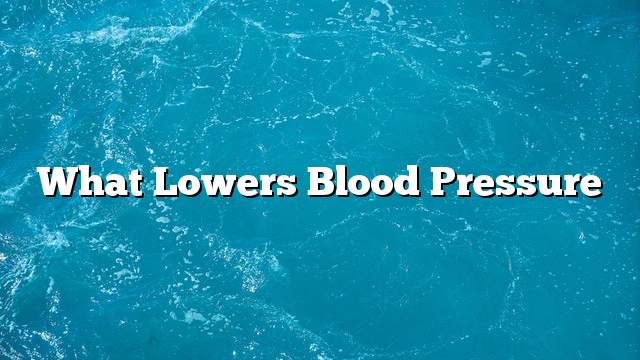blood pressure
Blood Pressure (Blood Pressure) is defined as the force that blood causes on the walls of blood vessels when the heart pumps it into the vessels in the body. The blood pressure reading consists of two digits, one above the other, for the figure at the top is systolic blood pressure; the maximum value reached by the blood pressure when the heart muscle contractions. For the figure below, Diastolic Blood Pressure is the lowest value of blood pressure when the heart muscle is relaxed. Blood pressure is measured using millimeters of mercury.
Practices for lowering blood pressure
According to the latest recommendations and guidelines for blood pressure published in the Canadian Heart Journal, the following practices contribute to lowering blood pressure and reducing the risk of infection:
- Exercise that requires moderate-intensity motor activity for 30 to 60 minutes for four days to seven days a week; such as walking, jogging, biking, and swimming.
- The body mass index (BMI) ranges from 18.5 kg / m2 to 24.9 kg / m2, taking into account the importance of weight loss to achieve optimal weight using several combined methods including behavioral factor, motor activity , And nutrition awareness.
- Eat vegetables, fruits, low fat dairy products, whole grains containing dietary fiber and plant proteins.
- Potassium intake in food is high in people who are not exposed to high potassium in the blood (Hyperkalemia) and from foods containing potassium bananas, watercress, roman lettuce, spinach, and other leafy vegetables.
- Reduce sodium consumption in food, so that the daily amount is 2000 milligrams.
- Reduce drinking alcohol.
- Adjust and reduce nervous tension.
Eating beet, which contains a high percentage of nitric oxide, and eating garlic, which helps increase the amount of nitric oxide in the blood contribute to reduce blood pressure, because of the Nitric Oxide expansion of blood vessels, in addition to eating fish such as Salmon, which contains high levels of omega-3 fatty acids (omegs-3 Fatty Acids), which can lower blood pressure, decrease inflammation and reduce triglycerides, in addition to containing your salmon trout vitamin D: Vitamin D) which has a testicle Y can lower blood pressure.
Drugs used to lower blood pressure
The following medicines are prescribed and used to control high blood pressure according to the instructions of the competent physician:
- Thiazide diuretics: Diuretics are substances that expel water and sodium from the body through the kidneys, thereby reducing blood volume. Diuretics containing thiazide are usually the first choice of blood pressure lowering drugs.
- Beta blockers: These drugs reduce the workload on the heart, opening the blood vessels, which reduces the speed and strength of heart rate. It is worth noting that it becomes more effective when used with another type of pressure reduction medication.
- Angiotensin-converting enzyme (ACE) inhibitors: These drugs relax the blood vessels by preventing them from forming a natural chemical in the body that causes narrowing of the blood vessels.
- Angiotensin II receptor blockers: These drugs reduce blood pressure by stopping the work of a natural chemical in the body that works to narrow the arteries, and does not prevent the formation of this substance.
- Calcium channel blockers: These drugs help relax the muscles of the blood vessels and reduce the speed of the heartbeat.
- Renin inhibitors: Slow down the production of renin, an enzyme produced by the kidneys that causes high blood pressure.
- Some other drugs include Alpha blockers, vasodilators, and others.
Diagnosis of hypertension
Blood pressure is diagnosed after several readings at different times. The person must have relaxed for at least five minutes. One reading does not mean blood pressure. According to the latest guidelines, the diagnosis of high blood pressure is increased when blood pressure readings Is 140/90 mmHg. For people over the age of 60, they are diagnosed with high blood pressure when reading more than 150/90 mmHg, and readings between 120/80 and 139/89 are pre-hypertension , And may affect several factors in blood pressure readings such as age, mental state, Some of the activities, and the drugs that the person is taking. It is very important to follow blood pressure readings regularly; because the height does not necessarily have symptoms and signs, and therefore called the disease of silent killer pressure rise.
Recommended blood pressure readings
The Eighth Joint National Committee recommended several new high blood pressure recommendations, which differ in strength, among which were recommendations for treating blood pressure in people 60 years of age Or more to achieve a reading of less than 150 milligrams of mercury pressure and diastolic pressure of less than 90 milligrams of mercury, and of people under the age of 60 with a view to reading a contraction of less than 140 millimeters of mercury and a diastolic pressure of less than 90 millimeters of mercury as seen by the doctor The Committee has recommended several And other recommendations relate to the pressure readings people who have chronic kidney disease or suffer from diabetes according to age and race.
It is worth mentioning that these recommendations and guidelines no longer define high blood pressure, and the definition of high blood pressure reading for 140/90 mmHg in the recommendations of JNC 7 is still acceptable to the Council.
